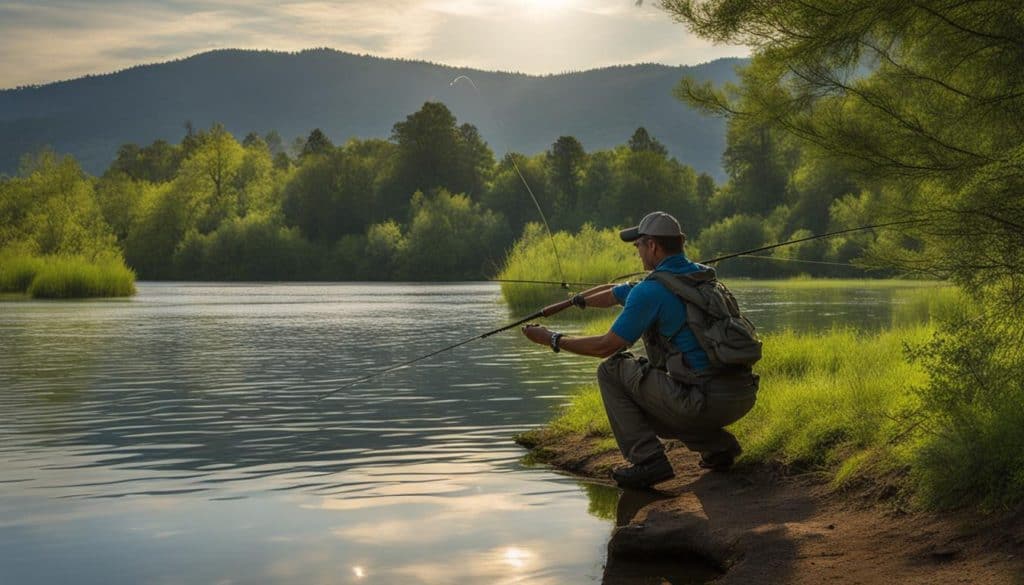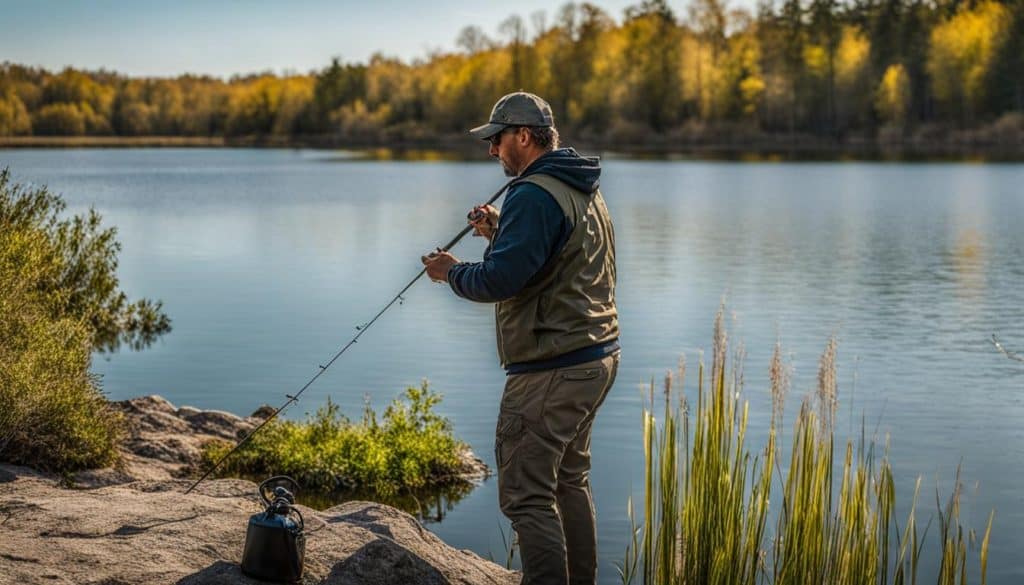Are you tired of coming home empty-handed after a day of bass fishing? Do you feel like you’re missing something but can’t quite put your finger on it? Chances are, you may be making some common mistakes that many bass fishermen make.
Fishing for bass can be challenging, but with the right techniques and strategies, you can improve your chances of a successful day on the water. In this section, we will explore the top bass fishing mistakes and provide tips on how to avoid them. By understanding these common errors, you can enhance your skills and increase your chances of reeling in that big bass you’ve been dreaming of.
Key Takeaways:
- Understanding common mistakes can greatly improve your chances of catching bass.
- The right techniques and strategies can make all the difference.
- Conducting proper research and having patience is crucial in bass fishing.
- Lure presentation and location selection are also key factors in catching bass.
- Avoiding these common mistakes will greatly enhance your chances of a successful bass fishing expedition.
Not Using the Right Equipment
Using the right equipment is crucial for successful bass fishing. If you’re new to the sport, it can be overwhelming to choose the right gear. Here are some bass fishing tips on selecting the right equipment for you.
Not Using the Right Equipment
| Equipment | Tips |
|---|---|
| Fishing rod | Choose a rod that has the correct action and weight for the type of lure(s) you will be fishing. |
| Reel | Pair your rod with an appropriately sized baitcasting or spinning reel that matches your rod. |
| Line | Choose a line that matches the weight of your lure and the conditions of the water. Monofilament lines are a good choice for beginners and budget anglers. |
| Lures | Select lures based on the conditions of the water, time of year and bass behavior. Crankbaits, jigs, and soft plastics are versatile options that work in a variety of situations. |
It’s also important to keep in mind that quality gear can make a significant difference. Investing in good equipment can improve your casting, accuracy, and sensitivity, which can lead to more successful catches. For several budget friendly but quality fishing rod and reel options, check out this article.
Using the right equipment is one of the most important bass fishing techniques you can learn. By following these bass fishing tips, you’ll have a better chance of catching bass on your next expedition.
Neglecting Proper Research
For beginner bass fishermen, proper research is often overlooked. However, it is essential to know the habits, preferred habitats, and feeding patterns of bass in order to increase your chances of success. Conducting research is also necessary for finding the best fishing spot, understanding the weather conditions and water conditions, and selecting the right gear for the job.
Importance of Understanding Bass Habits
Understanding bass habits is crucial to successful fishing. Knowing when and where bass are most active can increase your chances of finding and catching them. Bass tend to be more active during dawn and dusk and prefer water temperatures ranging from 65 to 75 degrees Fahrenheit. They also tend to feed on specific types of bait depending on the season. By researching and understanding these patterns, you can adjust your techniques and increase your chances of success.
Tips for Proper Research
One way to conduct proper research is by talking to local fishermen or bait shops. They can provide valuable insight into the best fishing spots, the type of bait and gear to use, and weather and water conditions. You can also use online resources, such as fishing forums and social media groups, to gather information on fishing spots and techniques.
| Tip | Info |
|---|---|
| Check local regulations | Be sure to check the local fishing regulations and obtain the appropriate licenses before heading out to fish. |
| Research the fishing spot | Understand the structure and cover of the fishing spot you plan to explore. Bass tend to hide in underwater structures and vegetation, so it’s important to know where to cast your line. |
| Stay up to date on weather conditions | Weather conditions can affect the behavior of bass, so it’s crucial to stay up to date on weather patterns before heading out to fish. Constantly check barometric pressure apps and the weather channel. |
By conducting proper research and understanding bass behavior, you can increase your chances of success and become a better bass fisherman. For more information on where and how to dial in where to catch your next big largemouth, visit this guide on where to find them.
Poor Casting Technique
Casting is a fundamental bass fishing technique that requires skill and practice to master. Many beginners make common mistakes, including using too much force, improper grip and stance, and poor timing, which can result in ineffective casting that scares off the fish.
One of the most critical aspects of casting is accuracy. A precise cast can make the difference between catching a trophy bass or going home empty-handed. To improve your casting technique, try these tips:
- Relax: Start with a relaxed grip and stance. Tension in your body can transfer to your casting, resulting in a jerky motion that can spook nearby fish.
- Timing: Timing is everything in casting. Release the line when your rod is at the 11 o’clock position, and follow through with a smooth, fluid motion.
- Power: Use just enough power to get your lure where you want it. Overpowering your cast can result in poor accuracy and control.
- Practice: The more you practice, the better your casting technique will become. Find an open space and practice casting at different distances and angles. This is simply achieved when trying to learn how to throw a baitcaster. Tie a lure with no treble hooks or a taped up football jig, and practice casting and pitching at different objects in the yard. You will be blown away how quickly you progress on making better casts and avoiding backlashes.
For the visual guys, check out this video by Fish the Moment on how-to practice your baitcasting in the yard.
It’s also important to note that different lures require different casting techniques. If you are trying to skip a jig under a dock, it will require a much different casting approach than bombing a frog out in lily pads. Practice and be prepared for several different situations.

Ignoring Seasonal Patterns
One of the biggest mistakes bass fishermen make is ignoring seasonal patterns. Bass behavior varies depending on the time of year, and it’s essential to adjust your techniques and lure selection accordingly.
In the spring, bass typically move to shallow water areas to spawn. During this time, it’s best to use lures that mimic baitfish like jerkbaits and swimbaits. Summer months can be challenging as bass tend to become more lethargic in warmer water temperatures. When the water heats up, it’s best to fish in the early morning or late evening when the water is cooler. In the fall, baitfish move to shallow water to feed, and bass follow suit. Lures that imitate baitfish are again most effective. In winter, bass move to deeper water and become less active. It’s recommended to fish slowly with jigs or plastics that mimic crawfish or worms.
Bass Fishing Techniques by Season
| Season | Preferred Techniques |
|---|---|
| Spring | Jerkbaits, swimbaits, lures that mimic baitfish |
| Summer | Topwater lures, Texas rigged plastics, early morning or late evening fishing |
| Fall | Crankbaits and spinnerbaits, fishing in shallow water |
| Winter | Jigs, plastics that mimic crawfish or worms, slow fishing |
By understanding the behavior of bass during each season, you can tailor your approach and increase your chances of catching more bass. Don’t forget to adjust your lure presentation and fishing location based on the seasonal patterns.
Lack of Patience
One of the most common mistakes that beginner bass fishermen make is not having enough patience. Many anglers give up too easily or switch spots too frequently, missing out on potential catches. It’s important to remember that fishing, especially for bass, requires patience and persistence. Don’t be afraid to make several casts to a specific piece of structure, like a log or grass patch. Pressured bass take finesse and different presentations to get them to bite.
When you’re out on the water, take the time to observe the surroundings and look for signs of fish activity. Pay attention to the water movement, the presence of baitfish, and any other clues that can help you identify a potential bass hotspot.
Another important aspect of patience is giving your bait enough time to attract fish. It can take some time for bass to notice your lure, so resist the urge to reel it in and recast too frequently with finesse lures. Instead, try different presentation techniques, like pausing or twitching your bait, to entice the fish to strike.
Remember, patience is key to successful bass fishing. Don’t get discouraged if you don’t catch anything right away. Keep trying and experimenting with different techniques until you find what works best for you.

Beginner Bass Fishing Mistakes to Avoid
Impatience is one of the most common beginner bass fishing mistakes. Take your time, cover water efficiently, and always be willing to try something new!
Incorrect Lure Presentation
Using the right lure for bass fishing is important, but it is equally crucial to present it correctly. Lure presentation involves the way you move your bait, and it can make the difference between success and failure.
One common mistake anglers make is retrieving their lure too quickly or too slowly. The speed of your retrieve depends on the type of lure you are using, as well as the water temperature and conditions. In colder water, for example, a slower retrieve may be more effective, while in warmer water, a faster retrieve may work better.
Another mistake to avoid is using the same retrieve pattern repeatedly. Bass can become accustomed to a particular presentation, making it less effective. Try varying the speed and rhythm of your retrieval, incorporating pauses, jerks, and twitches. This will make your lure more enticing and mimic the natural movement of prey.
Take note of the depth of the water you are fishing in and adjust your presentation accordingly. If bass are holding deep, using a slow and steady retrieve may be more effective than a fast and erratic one.
Finally, the type of lure you choose will affect your presentation. For example, a topwater popper requires a different presentation than a deep-diving crankbait. Take the time to experiment with different retrieve techniques and lures until you find what works best for the conditions you are fishing in.
Practice Makes Perfect
Don’t be discouraged if you don’t catch any bass right away. Bass fishing is a skill that takes time to develop. Keep practicing and refining your techniques, and eventually, you’ll see a difference in the size and number of fish you catch.
With the right attitude and determination, you too can become a successful bass angler. So, grab your gear and head out to the water, and put these tips and techniques to the test.
Conclusion
Improving your bass fishing skills takes time, effort, and patience. By acknowledging the common mistakes that anglers make, and taking the necessary steps to avoid them, you can increase your chances of a successful fishing trip.
Remember to use the right equipment, research the local fishing spots, and recognize the seasonal patterns that impact bass behavior. Master your casting technique, stay persistent, and choose prime fishing locations with care.
Tight lines,
Dawson
